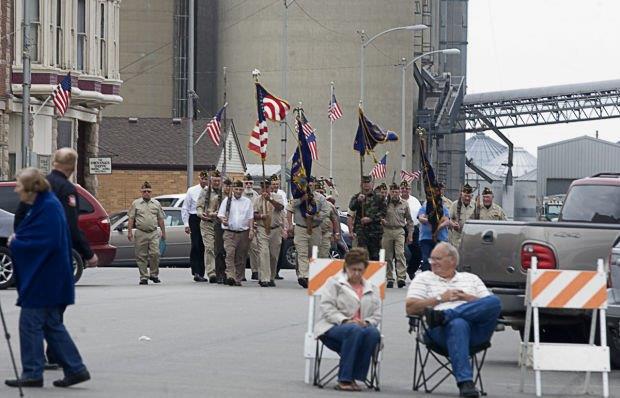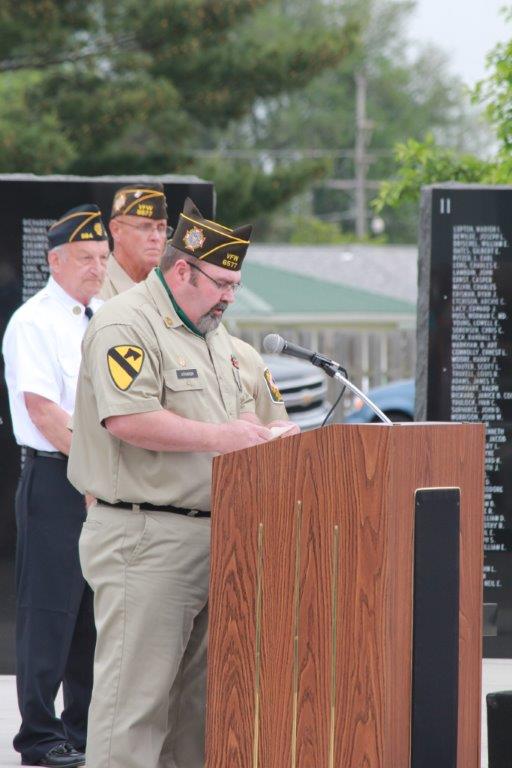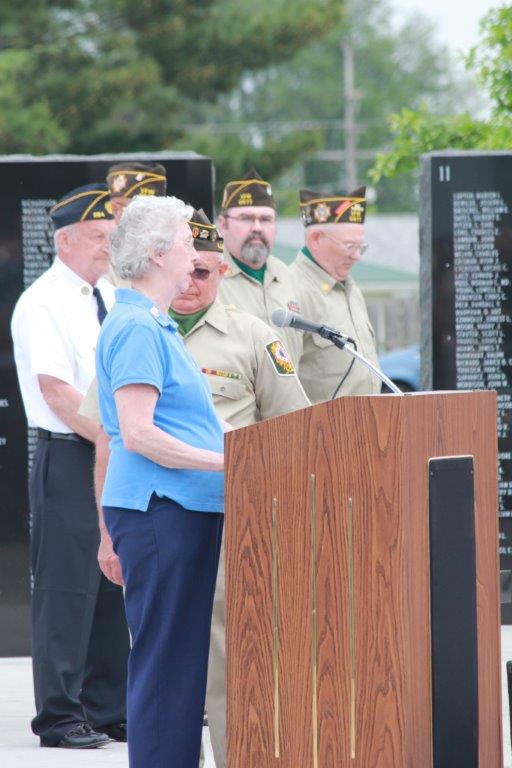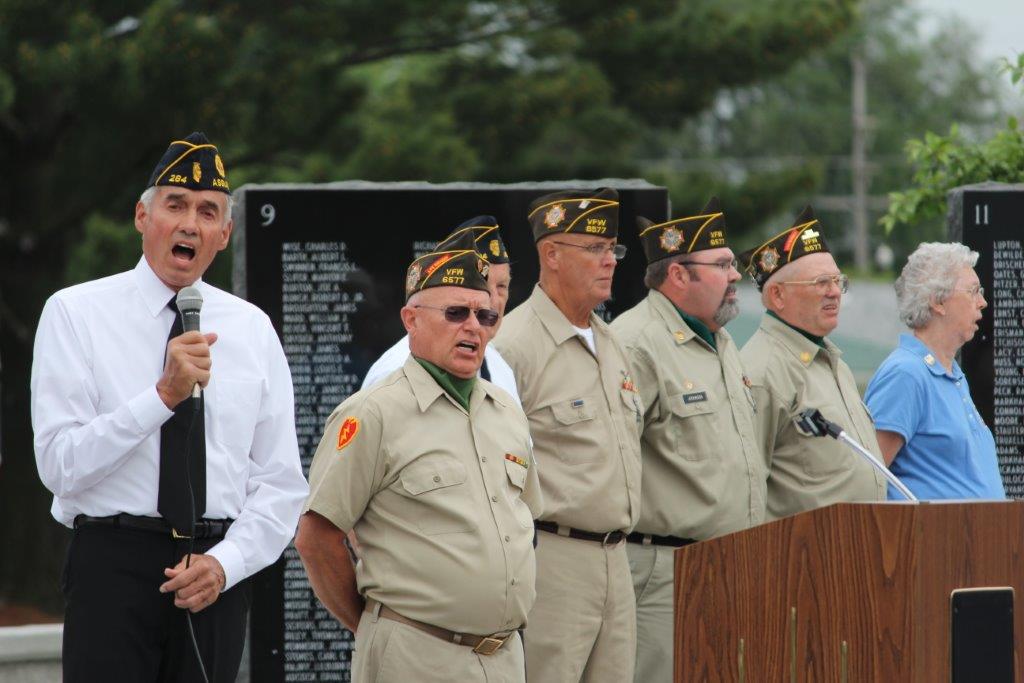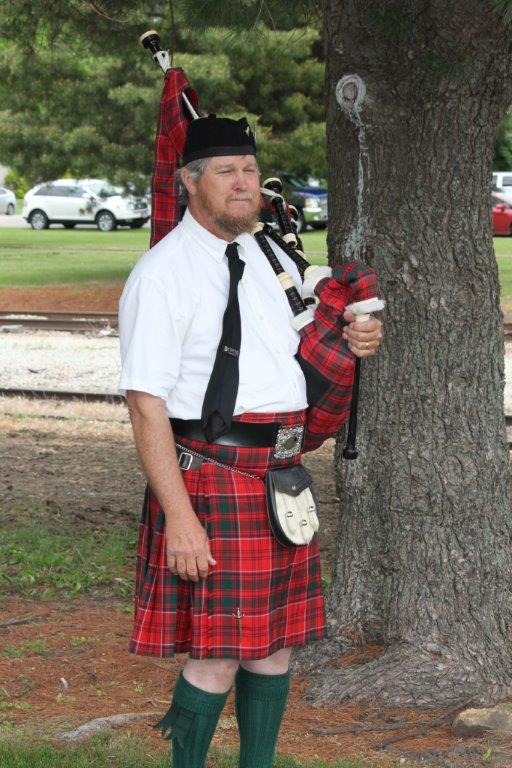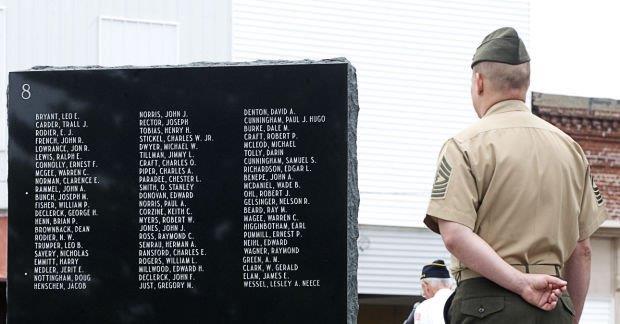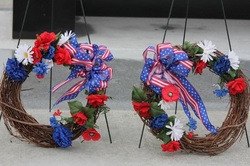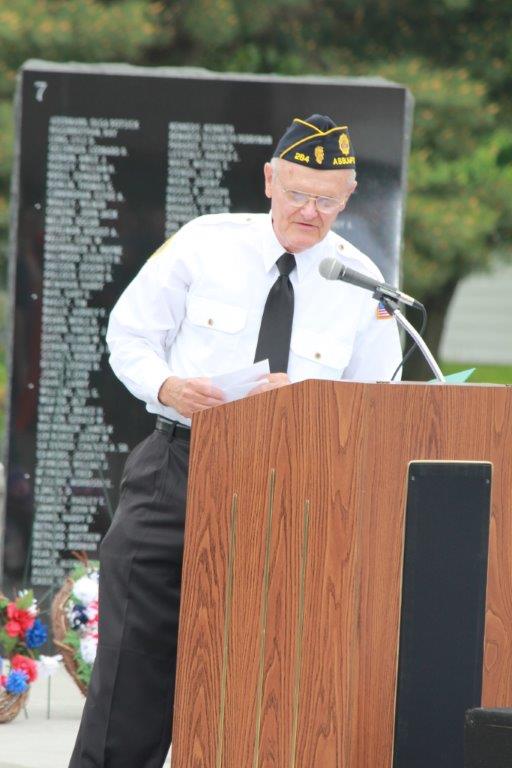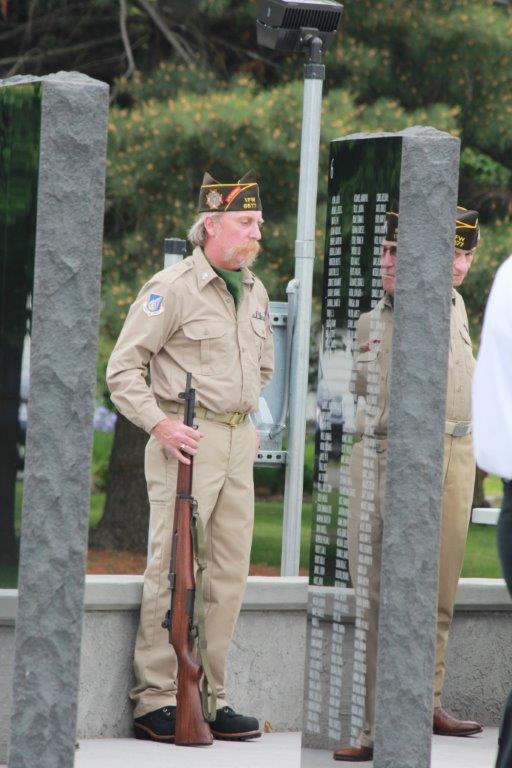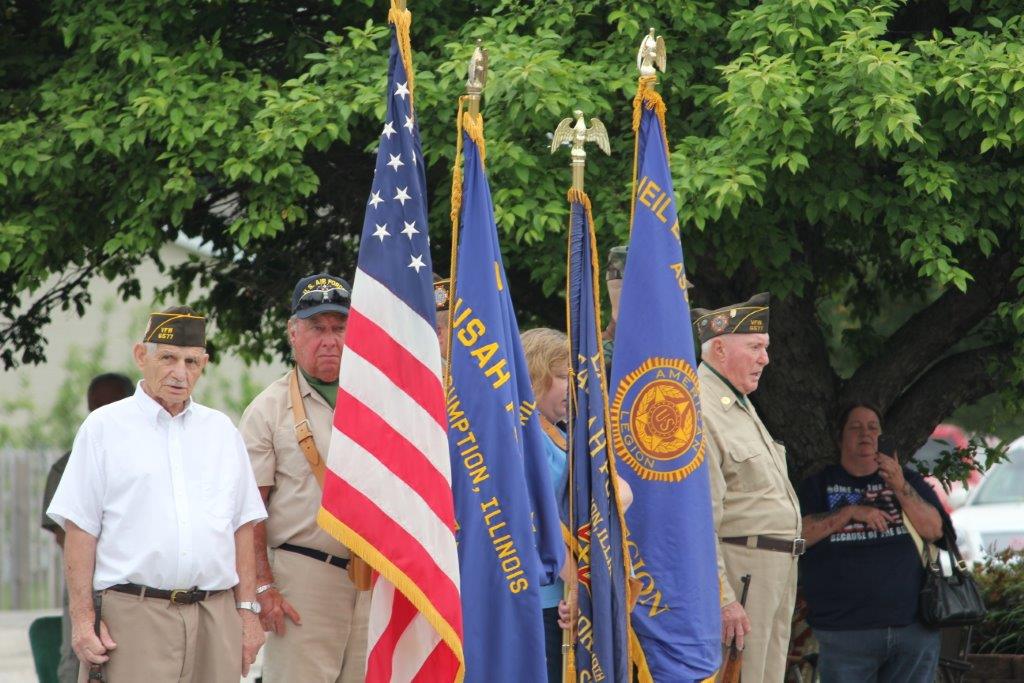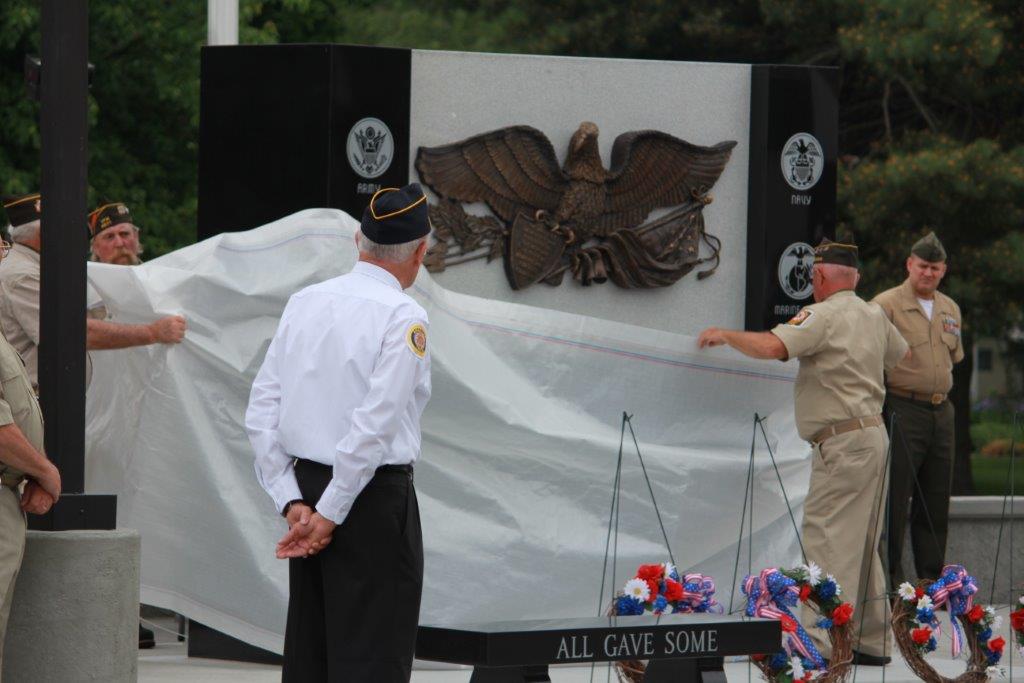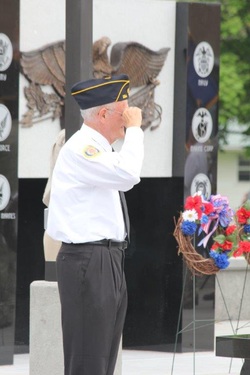MEMORIAL DEDICATION
What's New: Additional names added to the Memorial for Memorial Day on 5/11/23. Please click HERE to view the most current list.
Several hundred people observed the dedication of the Assumption Veterans Memorial on Sunday, May 25, 2014. The people of Assumption, showing that they cared about their veterans and community, continued their support of the Memorial that they have had from its inception. A fitting monument to our veterans now exists because of your monetary support and encouragement given the memorial committee. Sunday's ceremony was an emotional event that will never be forgotten by those in attendance. Assumption can be justifiably proud of its Veterans Memorial.
At the bottom of this page are pictures taken on Dedication Day.
The Dedication began promptly at 2PM as the Assumption VFW/American Legion Honor Guard rounded the bank corner marching in formation, bagpiper playing, and took their positions in front of the Memorial and the large crowd that had assembled for the event. The ceremony began with the lowering of the US flag to half-staff. Jack Erisman then asked the audience to join him in the singing of "The Star Spangled Banner".
The Honor Guard was then asked to fall out to their places followed by a song by bagpiper Joe Readnour of Moweaqua. The invocation was offered next by Michael St. Louis.
John Bonn then made recognitions as follows:
Veterans Memorial Committee members: Norman Bethard, John Bonn, James Bugg, Ronald Mink, Carl Puckett and William Sullivan.
Designer and Sculptor of the Monument: Robert Dondeville of Decatur.
Maker and Erector of the Monument: Dan Spence of Spence Monument Company of Charleston.
Concrete work: Castle Concrete Construction Inc. of Pana.
Lighting and Electrical work: Jane and Greg Butcher, owners of GAB Electric of Assumption
Rock, fill dirt, drainage tile, and high hoe work: John Holthaus and Holthaus Beyers Drainage of Assumption
Ground preparation: City of Assumption employees, Moore Brothers and John Mitsdarffer
Sound/PA system: Todd Musick - Buck Wild Entertainment
The committee would also like to recognize Angela Damery and the entire staff at the Golden Prairie News for all their help in printing the veterans articles and project news over the years.
The crowd was then asked to be seated and any veterans in the audience to please remain standing. Applause was then requested and received for the veterans in attendance and for those just recognized.
Next, the center monument featuring the bronze eagle sculpted by the Memorial designer Bob Dondeville from Decatur was unveiled for the first time.
Memorial Dedication Day speaker James Bugg then approached the podium. He began his remarks thusly:
“Although all Veterans Memorial Committee members did an equally fine job at their tasks, all members agree that Norman Bethard deserves special recognition. He, along with the help of his wife Jerri, collected and verified all the veterans names placed on the monument. It was a massive task well done.”
James then began his Dedication address:
All Gave Some; Some Gave All
“To paraphrase part of President Lincoln’s Gettysburg address: Assumption will little note, nor long remember what we say here, but it can never forget our soldiers and what they did for us. The old barrack’s song says old soldiers just fade away. Because of the Assumption Veterans Monument, our veterans will never fade away.
When the Veteran’s Committee was given the task of building a suitable monument to honor Assumption Veterans in the spring of 2011, we were eager to start but a little dubious. The very first decision we made was to hire Bob Dondeville as our designer which was wise because not only did Bob come up with a great design, but his advice was extremely helpful. But, the hardest task facing us was raising the money. After conferring with Bob Dondeville and Dan Spence of Spence Monument, it was decided that at least $80,000 would be needed to complete the project. That seemed an insurmountable amount to ask a community of just over 1100 people to raise. But, we didn’t understand how much the people of Assumption cared about their community and their veterans. By Memorial Day 2013, a year ago, we had over $100,000 in the bank. At that time, the committee decided to stop asking for more money until we saw how much would be needed. How many fund raisers ever had that problem? There are still people willing to give us more, if needed. Remember, this money was raised by Assumption people, no government grants, no foundation gifts. We can be justifiably proud of that feat and we deserve a hand. After all bills are paid, we will still have about $7,000 to landscape and maintain the site.
When Bob Dondeville was searching for a site to place his veterans monument in Mt Zion, he went before the school board to request permission to put it on school grounds. One school board member objected to the peace symbol worn by his Vietnam soldier and another to the bandolier and grenade he wore. Bob replied, “Taking away those things would take away all meaning from the sculpture. What I would have is a UPS man if I did that.”
The peace symbol and the grenade represent the two conflicting dilemmas that all our soldiers face. In their hearts they want peace. We all do. They are raised in a country that values life. We are taught that life is sacred, and we should not kill. We keep loved ones alive as long as possible.
Then, their country asks them to go to war and kill people. It is a dilemma that they grapple with, seeing their fellow solders killed and killing enemy soldiers. Larry Howse, who received four Purple Hearts in Vietnam, was on his first patrol in Vietnam when a Vietcong jumped out of the bushes and killed a fellow soldier. It was the first time Larry had ever seen a dead person. Kenny Sloan was walking on a trail in Vietnam when an enemy soldier appeared on the trail before him. He didn’t have any choice but to kill him, but that soldier’s face still haunts him. Bob DeBrun was in pain all his life from a leg wound suffered in Korea. He was hit with shrapnel from an exploding grenade when trying to rescue a wounded buddy. His daughter, Jill, said that when asked by a doctor to describe his pain on a scale of one to ten, he replied, “That has no meaning to me because I have had pain all my life.” Yet, when ask by a student at a Veteran’s Day observance at Central A & M Middle School if he had killed anyone, Bob replied, “I hope not.”
No, they did not want to go to war, but when asked to do so they went. Why? They believed in freedom and democracy. They wanted to protect their way of life.They fought so “that government of the people, by the people, for the people, would not perish from the earth”. That their nation founded on the ideal that all men are created equal would still be here for their children and their children’s children. Many attempts at governments so construed have failed in the past.
When our Civil War started many other nations said, “See, the United States as a democracy is going to fail.” But we had Andrew Johnson from Assumption, IL, who didn’t let that happen. Johnson joined the 116th Illinois Infantry at Assumption, IL, and was awarded the Medal Of Honor for being part of the ‘storming party’ at Vicksburg May 22, 1863. The only Assumption veteran to earn that high award. Johnson was among 300 to volunteer of which 150 were chosen to run across a ravine to place ladders against an earthen fort to scale its walls. Of the 150 soldiers that attempted the mission, only about half survived the failed attempt.
In WW I, Emmet Heiter, Marguerite Jackson’s father, answered the call to help protect democracy from a militaristic government that wanted to conquer other people’s lands. In the trench warfare in WW I, a unit would be sent up to the front for a few days, and then brought back to rest for few days. Emmett said that not nearly as many came back as went to the front. Moose Jaw, Canada, where Emmet lived when he went to war, was a city of about 20,000 in 1915. Of the 4,099 people sent from Moose Jaw to the front during World War I, only 1200 came home. Moose Jaw lost almost 15 percent of its population to the war.
Italian dictator, Benito Mussolini, said, “Democracy is beautiful in theory; in practice it is a fallacy.” His cohort Hitler, commenting on us as the melting pot of different peoples and cultures, said we were a feeble people because we weren’t a pure race. Robert Smith, Tessa Giles’ dad, answered him when as a tank driver for General Patton’s II Corp, he helped defeat the Germans in a deciding tank battle during the Battle of El Guettar in North Africa. Verl Fisher piloted his B-17 Flying Fortress and its crew deep into Germany without fighter escort to attack Hitler’s ball bearing plants. Twenty-five missions were required to go home, On his 24th, he was shot down and spent 18 months in a German prison camp. Those flights had a casualty rate of almost 50%. Hitler and Rommel, at the beginning of WW II, thought we were weak and not good soldiers, but Bob and Verl proved them wrong along with Vivian Keisecomb Wendling who volunteered to be a nurse close to the front lines, and Bill Rohweder who bailed out of his disabled plane over the English Channel never to be seen again. They did not let Hitler and Mussolini destroy our democracy.
On the other side of the world, Japan decided that they could destroy our influence in the Pacific Ocean allowing them to conquer countries in that region by attacking Pearl Harbor December 7, 1941. But they misjudged us, too. Admiral Yamamoto, leader of the Japanese forces that attacked Pearl Harbor, had a premonition of what was to happen when he allegedly said, "I fear all we have done is to awaken a sleeping giant and fill him with a terrible resolve.” That terrible resolve was fulfilled by soldiers like Bob Brackett who lost a leg during the successful battle to take Okinawa, and Freddie Temperley, our mailman that the kids followed around in the summertime, who was injured in the Battle of Leyte. Remember General MacArthur striding ashore at Leyte proclaiming he had returned to the Philippines? Freddie was already there. His injury healed in time for him to participate in the Battle of Okinawa where he was wounded again. Lyle Nicol was wounded from shrapnel to both thighs, chest, and left arm helping capture Hill 21 on the Island of Cebu. While in the Philippines Bill Sullivan was badly burned in an explosion. Many other veterans served in the Pacific during WW II: Carlos Fathauer, Lyle Eversole, Noel Herbert, Bob Bilyeu, Bob Craft, Rudy Endrizzi, and Carlyle Bantner just to name a few.
In June 1950, the North Koreans attacked South Korea. Again, our soldiers responded. Bob DeBrun was cited for heroism. Red DeClerck was knocked unconscious. When he awoke, he was lying among dead soldiers and enemy soldiers were stripping valuables from them. He played dead to escape but didn’t find his unit for three days. Another time his unit was pinned down by machine gun fire. His leader would call out names to run through the fire to get behind the machine gunner. Red was the third soldier called after the first two had been killed. He made it and was able to disable the machine gun to allow his unit to escape. He received two Bronze Stars. Others served in Korea like Tom Adermann, Marion Waddington and Bill Williams.
Many Assumption people served in Vietnam. Ronnie Throneburg learned that he had a new son, Troy, aboard a boat on the MeKong River. Every time he boarded a helicopter on a search and destroy mission, he had to wonder if he would ever get to hold him. Joe Mink was a tunnel rat that searched Vietcong tunnels. Gary Caulk manned a machine gun all night to keep his position from being overrun by North Vietnamese. Joe Smith, a jet fighter pilot, was shot down and lost over Cambodia. Tim Bodden lost his life in Vietnam. Others like Buck Schmahl, Norm Bethard, and Richard Ruff who had two tours of duty in Vietnam also served.
Bob Ludwig served in the northernmost surgical support company in Desert Storm. Before leaving on a dangerous mission while in Iraq, Ryan Erisman had two pictures taken of himself to make sure one of them got back to his family.
Many career people like Jane Brackett, Charles Jackson, Rod Pinkston, Bob Turntine, Brian Pinkston, Roger Fouts, Matt Bethard, Adam Bethard, Mike Dechy, and Josh Mills were in and out of danger in Desert Storm, Afghanistan, and Iraq.
There is a group of soldiers like Vinnie and Mark Zuber, Walter Younker, Scott Stauter, Jack Erisman, Ron Mink, Carl Puckett, Bill Dailey, John Bonn, Robert Ashinhurst, Larry Cutler, Jerit Medler, and Don Shuck, who never saw combat. When they were drafted or enlisted, they did not know that would be the case. They still took time out, 2, 3, 4 years, from their lives and careers to serve their country.
I have only touched on the lives of a few of our veterans as examples. They all have a story to tell. When you look at the names on the monument behind me, don’t just read a name and go on. Think about the story behind that name. They all did something to protect your freedoms.
Our veterans cry out to us, 'Please, don’t forget us.' "
Following James' speech another song was played by bagpiper Joe Readnour.
The Dedication of the Monument followed lead by Norman Bethard and Ronald Mink.
Then we had the laying of the wreaths by the Senior Vice Commander, Junior Vice Commander, Officer of the Day, and the Madame President of the Ladies Auxiliary.
Jack Erisman then led the crowd in the singing of "God Bless America".
The firing squad fired a 21-gun salute which was followed by the playing of taps.
The bagpiper played "Danny Boy" as he marched away and the music faded into the distance while Michael St. Louis offered the benediction.
This concluded the Dedication.
Below are pictures taken on Dedication Day.
Several hundred people observed the dedication of the Assumption Veterans Memorial on Sunday, May 25, 2014. The people of Assumption, showing that they cared about their veterans and community, continued their support of the Memorial that they have had from its inception. A fitting monument to our veterans now exists because of your monetary support and encouragement given the memorial committee. Sunday's ceremony was an emotional event that will never be forgotten by those in attendance. Assumption can be justifiably proud of its Veterans Memorial.
At the bottom of this page are pictures taken on Dedication Day.
The Dedication began promptly at 2PM as the Assumption VFW/American Legion Honor Guard rounded the bank corner marching in formation, bagpiper playing, and took their positions in front of the Memorial and the large crowd that had assembled for the event. The ceremony began with the lowering of the US flag to half-staff. Jack Erisman then asked the audience to join him in the singing of "The Star Spangled Banner".
The Honor Guard was then asked to fall out to their places followed by a song by bagpiper Joe Readnour of Moweaqua. The invocation was offered next by Michael St. Louis.
John Bonn then made recognitions as follows:
Veterans Memorial Committee members: Norman Bethard, John Bonn, James Bugg, Ronald Mink, Carl Puckett and William Sullivan.
Designer and Sculptor of the Monument: Robert Dondeville of Decatur.
Maker and Erector of the Monument: Dan Spence of Spence Monument Company of Charleston.
Concrete work: Castle Concrete Construction Inc. of Pana.
Lighting and Electrical work: Jane and Greg Butcher, owners of GAB Electric of Assumption
Rock, fill dirt, drainage tile, and high hoe work: John Holthaus and Holthaus Beyers Drainage of Assumption
Ground preparation: City of Assumption employees, Moore Brothers and John Mitsdarffer
Sound/PA system: Todd Musick - Buck Wild Entertainment
The committee would also like to recognize Angela Damery and the entire staff at the Golden Prairie News for all their help in printing the veterans articles and project news over the years.
The crowd was then asked to be seated and any veterans in the audience to please remain standing. Applause was then requested and received for the veterans in attendance and for those just recognized.
Next, the center monument featuring the bronze eagle sculpted by the Memorial designer Bob Dondeville from Decatur was unveiled for the first time.
Memorial Dedication Day speaker James Bugg then approached the podium. He began his remarks thusly:
“Although all Veterans Memorial Committee members did an equally fine job at their tasks, all members agree that Norman Bethard deserves special recognition. He, along with the help of his wife Jerri, collected and verified all the veterans names placed on the monument. It was a massive task well done.”
James then began his Dedication address:
All Gave Some; Some Gave All
“To paraphrase part of President Lincoln’s Gettysburg address: Assumption will little note, nor long remember what we say here, but it can never forget our soldiers and what they did for us. The old barrack’s song says old soldiers just fade away. Because of the Assumption Veterans Monument, our veterans will never fade away.
When the Veteran’s Committee was given the task of building a suitable monument to honor Assumption Veterans in the spring of 2011, we were eager to start but a little dubious. The very first decision we made was to hire Bob Dondeville as our designer which was wise because not only did Bob come up with a great design, but his advice was extremely helpful. But, the hardest task facing us was raising the money. After conferring with Bob Dondeville and Dan Spence of Spence Monument, it was decided that at least $80,000 would be needed to complete the project. That seemed an insurmountable amount to ask a community of just over 1100 people to raise. But, we didn’t understand how much the people of Assumption cared about their community and their veterans. By Memorial Day 2013, a year ago, we had over $100,000 in the bank. At that time, the committee decided to stop asking for more money until we saw how much would be needed. How many fund raisers ever had that problem? There are still people willing to give us more, if needed. Remember, this money was raised by Assumption people, no government grants, no foundation gifts. We can be justifiably proud of that feat and we deserve a hand. After all bills are paid, we will still have about $7,000 to landscape and maintain the site.
When Bob Dondeville was searching for a site to place his veterans monument in Mt Zion, he went before the school board to request permission to put it on school grounds. One school board member objected to the peace symbol worn by his Vietnam soldier and another to the bandolier and grenade he wore. Bob replied, “Taking away those things would take away all meaning from the sculpture. What I would have is a UPS man if I did that.”
The peace symbol and the grenade represent the two conflicting dilemmas that all our soldiers face. In their hearts they want peace. We all do. They are raised in a country that values life. We are taught that life is sacred, and we should not kill. We keep loved ones alive as long as possible.
Then, their country asks them to go to war and kill people. It is a dilemma that they grapple with, seeing their fellow solders killed and killing enemy soldiers. Larry Howse, who received four Purple Hearts in Vietnam, was on his first patrol in Vietnam when a Vietcong jumped out of the bushes and killed a fellow soldier. It was the first time Larry had ever seen a dead person. Kenny Sloan was walking on a trail in Vietnam when an enemy soldier appeared on the trail before him. He didn’t have any choice but to kill him, but that soldier’s face still haunts him. Bob DeBrun was in pain all his life from a leg wound suffered in Korea. He was hit with shrapnel from an exploding grenade when trying to rescue a wounded buddy. His daughter, Jill, said that when asked by a doctor to describe his pain on a scale of one to ten, he replied, “That has no meaning to me because I have had pain all my life.” Yet, when ask by a student at a Veteran’s Day observance at Central A & M Middle School if he had killed anyone, Bob replied, “I hope not.”
No, they did not want to go to war, but when asked to do so they went. Why? They believed in freedom and democracy. They wanted to protect their way of life.They fought so “that government of the people, by the people, for the people, would not perish from the earth”. That their nation founded on the ideal that all men are created equal would still be here for their children and their children’s children. Many attempts at governments so construed have failed in the past.
When our Civil War started many other nations said, “See, the United States as a democracy is going to fail.” But we had Andrew Johnson from Assumption, IL, who didn’t let that happen. Johnson joined the 116th Illinois Infantry at Assumption, IL, and was awarded the Medal Of Honor for being part of the ‘storming party’ at Vicksburg May 22, 1863. The only Assumption veteran to earn that high award. Johnson was among 300 to volunteer of which 150 were chosen to run across a ravine to place ladders against an earthen fort to scale its walls. Of the 150 soldiers that attempted the mission, only about half survived the failed attempt.
In WW I, Emmet Heiter, Marguerite Jackson’s father, answered the call to help protect democracy from a militaristic government that wanted to conquer other people’s lands. In the trench warfare in WW I, a unit would be sent up to the front for a few days, and then brought back to rest for few days. Emmett said that not nearly as many came back as went to the front. Moose Jaw, Canada, where Emmet lived when he went to war, was a city of about 20,000 in 1915. Of the 4,099 people sent from Moose Jaw to the front during World War I, only 1200 came home. Moose Jaw lost almost 15 percent of its population to the war.
Italian dictator, Benito Mussolini, said, “Democracy is beautiful in theory; in practice it is a fallacy.” His cohort Hitler, commenting on us as the melting pot of different peoples and cultures, said we were a feeble people because we weren’t a pure race. Robert Smith, Tessa Giles’ dad, answered him when as a tank driver for General Patton’s II Corp, he helped defeat the Germans in a deciding tank battle during the Battle of El Guettar in North Africa. Verl Fisher piloted his B-17 Flying Fortress and its crew deep into Germany without fighter escort to attack Hitler’s ball bearing plants. Twenty-five missions were required to go home, On his 24th, he was shot down and spent 18 months in a German prison camp. Those flights had a casualty rate of almost 50%. Hitler and Rommel, at the beginning of WW II, thought we were weak and not good soldiers, but Bob and Verl proved them wrong along with Vivian Keisecomb Wendling who volunteered to be a nurse close to the front lines, and Bill Rohweder who bailed out of his disabled plane over the English Channel never to be seen again. They did not let Hitler and Mussolini destroy our democracy.
On the other side of the world, Japan decided that they could destroy our influence in the Pacific Ocean allowing them to conquer countries in that region by attacking Pearl Harbor December 7, 1941. But they misjudged us, too. Admiral Yamamoto, leader of the Japanese forces that attacked Pearl Harbor, had a premonition of what was to happen when he allegedly said, "I fear all we have done is to awaken a sleeping giant and fill him with a terrible resolve.” That terrible resolve was fulfilled by soldiers like Bob Brackett who lost a leg during the successful battle to take Okinawa, and Freddie Temperley, our mailman that the kids followed around in the summertime, who was injured in the Battle of Leyte. Remember General MacArthur striding ashore at Leyte proclaiming he had returned to the Philippines? Freddie was already there. His injury healed in time for him to participate in the Battle of Okinawa where he was wounded again. Lyle Nicol was wounded from shrapnel to both thighs, chest, and left arm helping capture Hill 21 on the Island of Cebu. While in the Philippines Bill Sullivan was badly burned in an explosion. Many other veterans served in the Pacific during WW II: Carlos Fathauer, Lyle Eversole, Noel Herbert, Bob Bilyeu, Bob Craft, Rudy Endrizzi, and Carlyle Bantner just to name a few.
In June 1950, the North Koreans attacked South Korea. Again, our soldiers responded. Bob DeBrun was cited for heroism. Red DeClerck was knocked unconscious. When he awoke, he was lying among dead soldiers and enemy soldiers were stripping valuables from them. He played dead to escape but didn’t find his unit for three days. Another time his unit was pinned down by machine gun fire. His leader would call out names to run through the fire to get behind the machine gunner. Red was the third soldier called after the first two had been killed. He made it and was able to disable the machine gun to allow his unit to escape. He received two Bronze Stars. Others served in Korea like Tom Adermann, Marion Waddington and Bill Williams.
Many Assumption people served in Vietnam. Ronnie Throneburg learned that he had a new son, Troy, aboard a boat on the MeKong River. Every time he boarded a helicopter on a search and destroy mission, he had to wonder if he would ever get to hold him. Joe Mink was a tunnel rat that searched Vietcong tunnels. Gary Caulk manned a machine gun all night to keep his position from being overrun by North Vietnamese. Joe Smith, a jet fighter pilot, was shot down and lost over Cambodia. Tim Bodden lost his life in Vietnam. Others like Buck Schmahl, Norm Bethard, and Richard Ruff who had two tours of duty in Vietnam also served.
Bob Ludwig served in the northernmost surgical support company in Desert Storm. Before leaving on a dangerous mission while in Iraq, Ryan Erisman had two pictures taken of himself to make sure one of them got back to his family.
Many career people like Jane Brackett, Charles Jackson, Rod Pinkston, Bob Turntine, Brian Pinkston, Roger Fouts, Matt Bethard, Adam Bethard, Mike Dechy, and Josh Mills were in and out of danger in Desert Storm, Afghanistan, and Iraq.
There is a group of soldiers like Vinnie and Mark Zuber, Walter Younker, Scott Stauter, Jack Erisman, Ron Mink, Carl Puckett, Bill Dailey, John Bonn, Robert Ashinhurst, Larry Cutler, Jerit Medler, and Don Shuck, who never saw combat. When they were drafted or enlisted, they did not know that would be the case. They still took time out, 2, 3, 4 years, from their lives and careers to serve their country.
I have only touched on the lives of a few of our veterans as examples. They all have a story to tell. When you look at the names on the monument behind me, don’t just read a name and go on. Think about the story behind that name. They all did something to protect your freedoms.
Our veterans cry out to us, 'Please, don’t forget us.' "
Following James' speech another song was played by bagpiper Joe Readnour.
The Dedication of the Monument followed lead by Norman Bethard and Ronald Mink.
Then we had the laying of the wreaths by the Senior Vice Commander, Junior Vice Commander, Officer of the Day, and the Madame President of the Ladies Auxiliary.
Jack Erisman then led the crowd in the singing of "God Bless America".
The firing squad fired a 21-gun salute which was followed by the playing of taps.
The bagpiper played "Danny Boy" as he marched away and the music faded into the distance while Michael St. Louis offered the benediction.
This concluded the Dedication.
Below are pictures taken on Dedication Day.


